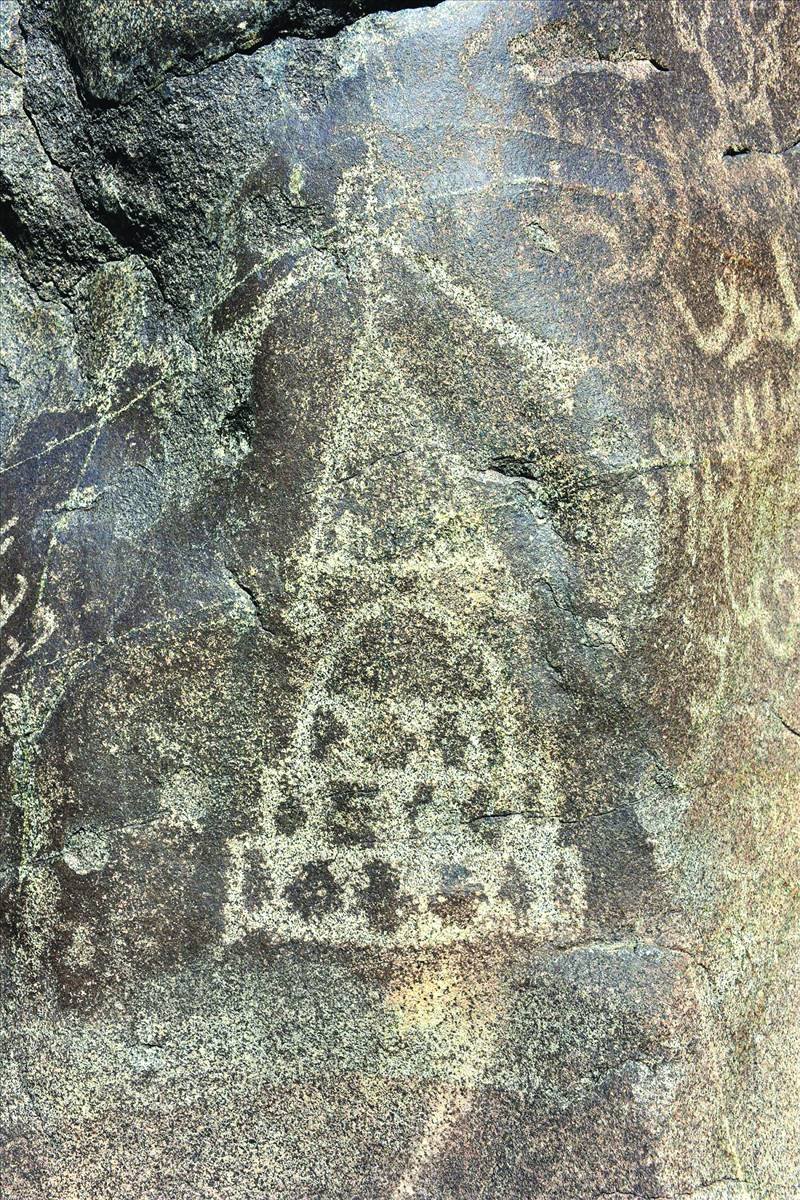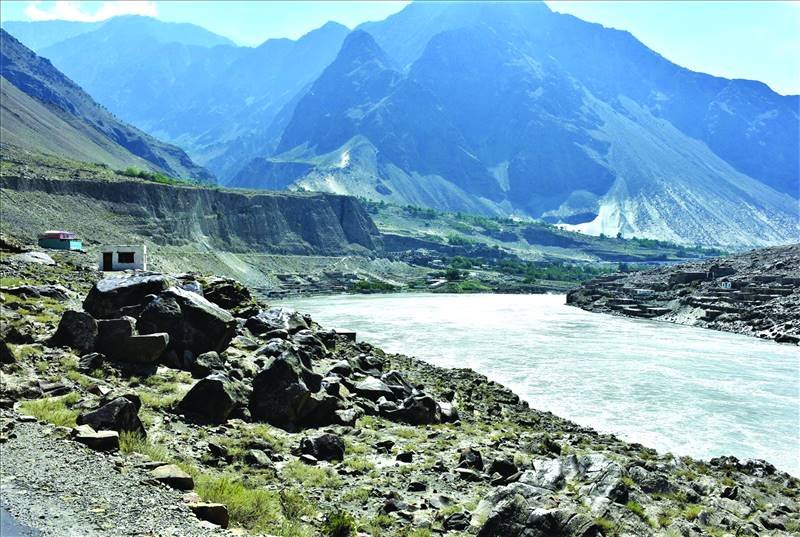
Anthropologist Zulfiqar Ali Kalhoro takes us to an invaluable site in the Indus-Kohistan region.
While traveling along the Karakorum Highway, one comes across many rock art sites that need to be promoted as potential tourist destinations. Sadly, they escape the attention of the authorities.
Rock art tourism plays a significant role in the local economy of communities in many of the countries in Africa and Europe. The best example would be at Val Camonica in Italy. The same model of promoting rock art tourism and involving the local community in the preservation of the sites be adopted in Pakistan.
Gilgit-Baltistan, the Swat valley and Sindh are three important regions in Pakistan where rock art tourism can be promoted.
Some of the rock art sites in Gilgit-Baltistan and Khyber-Pakhtunkhwa are well known to Western scholars but not to the international and national tourists. One such site is located near the town of Shatial.

Shatial is a small town located on the Karakorum Highway (KKH) and administratively falls in the Upper Kohistan district in Khyber-Pakhtunkhwa, which is known for Buddhist and Zoroastrian symbolism and hundreds of ancient scripts especially Kharosthi, Sogdian, Brahmi, etc. Even some Chinese inscriptions were recorded from this site. It is one of the best-preserved and prominent rock art sites in KP province. The antiquities here are managed by the Directorate of Archaeology and Museums of the Government of Khyber-Pakhtunkhwa. The site watchman is very vigilant: particularly in keeping an eye on tourists and travelers who sometimes vandalize the rock art images. A majority of the Buddhist images near Chilas have been vandalized but thanks to vigilance of the watchman, the Shatial rock art images have not been subjected to this horrendous practice.
There are some boulders at Shatial which are profusely covered with rock engravings, a majority of which face the River Indus. The most outstanding engraving here, which covers the entire surface of a boulder, is from the Buddhist tradition.
This boulder contains the story of the Shibi-Jataka. In Buddhist sacred tradition, the Jataka tales deal with episodes of Lord Buddha from his various incarnations. We find the Shibi Jataka tale is also represented in Gandhara art.

In the Shibi Jataka tale as depicted at the Shatial rock carvings, Buddha is shown seated and flanked by some glorious stupas. This is perhaps the most amazing Buddhist rock carving in the Upper Indus region. Although some fine specimens are also found in Chilas, the artistic rendering of the Shibi Jataka here reflects the high level of skill of the artists. A huge stupa engraving covers the face of the boulder, flanked by a few votive stupas. Near the huge stupa is a Kharosthti inscription from the 5th century AD, the text of which has been provided by Professor Ahmad Hasan Dani in his book Human Records on Karakorum Highway. The inscription records the name of the artist of the stupa as “religiously devout daughter of Jikhodarkha”.
According to Professor Ahmad Hasan Dani, this stupa is of Central Asian type. Professor Dani was the first Pakistani scholar to focus on the rock art of Gilgit-Baltistan, having written two books and a number of research papers discussing and deciphering the scripts which were found on the boulders, cliffs, and bedrocks along the Indus River and the ancient Silk Route. His research provided a baseline to other national and international rock art scholars, allowing them to further study specimens in Pakistan.
Professor Dani believed that the Shatial rock art site was an important place and was visited by many travelers, traders, and missionaries. The earliest recorded Kharosthi inscription here is, in fact, from the first century AD. The site probably served as a resting place for people coming from the Buddhist monastery of Phuguch in the Darel valley, which has been identified with “Ta-li lo” of famed 7th-century traveler Xuanzang (also Romanized as Hiuen Tsang) and “To-li” of 5th-century traveler Faxian (also Romanized as Fahien). According to Faxian, “To-li” (i.e. modern Darel) was the capital of U-Chang-na or Udyan (modern Swat). Both of the Chinese pilgrims spoke about a figure of the Maitreya, 100 feet high. This figure was found at the Phuguch monastery in present-day Darel – and strengthens the view that the Shatial site served as a resting place on the route.
But at Shatial, we are not dealing only with the Buddhist tradition.
Apart from stupa images, there are also engravings of Zoroastrian symbols, particularly fire altars. Many Sogdian inscriptions are also found at the Shatial rock art site which only shows the names of travelers who came all the way from modern Samarkand and a few from China. Some Brahmi inscriptions also give the name of Khasa tribe and their kings in the 5th century AD showing that many races lived in the vicinity of the present-day Gilgit-Baltistan and Indus-Kohistan. Were the Khasas a Dardic speaking people or a different race who spoke a different language?. This question further needs to be investigated by anthropologists, historians, and archaeologists.
On one of the boulders, some of the interesting tamgas (tribal brands) are also found which appear to have been engraved by Sogdian travelers and traders. Labyrinth symbolism, which is also found in other parts of the world in rock art, is also to be found here.
Hunting scenes are also found on a few boulders at the Shatial rock art site. Some rock carvings of phallic symbolism are also found at this site. Two of the boulders which lie close to each are fully covered with geometric and animal engravings. Some are simple animal renderings and others are highly stylized animal representations.
Tridents are also found at the rock art site of Shatial, showing that this symbol was probably associated with wandering ascetics of Nathism – which is now considered a form of Hinduism.
The rock art site of Shatial should be promoted as a tourist destination for national and international tourists. The Directorate of Archaeology and Museums at the Government of Khyber-Pakhtunkhwa, which is already doing a great job by promoting Buddhist sites in Swat, Mardan and other districts of the province, should also promote the rock art of Shatial in Upper Kohistan district.
This feature was first published by The Friday Times.
 Zulfiqar Ali Kalhoro is an anthropologist, has authored four books: ‘Symbols in Stone: The Rock Art of Sindh’, ‘Perspectives on the art and architecture of Sindh’, ‘Memorial Stones: Tharparkar’ and ‘Archaeology, Religion, and Art in Sindh’. He may be contacted at: zulfi04@hotmail.com
Zulfiqar Ali Kalhoro is an anthropologist, has authored four books: ‘Symbols in Stone: The Rock Art of Sindh’, ‘Perspectives on the art and architecture of Sindh’, ‘Memorial Stones: Tharparkar’ and ‘Archaeology, Religion, and Art in Sindh’. He may be contacted at: zulfi04@hotmail.com
